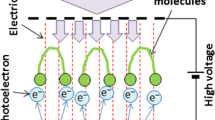Abstract
The degradation mechanisms of some perfluoropolyether lubricants, model lubricants and DLC coating were studied in this paper. The degradation fragments from the tests of the PFPE lubricants can be divided into two groups. One group includes the gas fragments containing fluorine atoms, which are generated from the decomposition of the lubricants themselves; while the other group, including H2, C2H3, C2H5, and CO2, is generated from the degradation of the DLC coating on the disk surfaces. The test results from the model lubricants clearly show that the carbon dioxide produced in the tests is generated from the DLC coating, not from the decomposition of the lubricants or model lubricants. The C–O bond is a weak bond in both the lubricant and model lubricant molecules; it is easier to be broken. Because of the polar characteristics of the C–O bond, it is easy to be attacked and broken down by low-energy electrons generated during sliding. Triboelectrical reaction is a dominant degradation mechanism of the lubricants and model lubricants.
Similar content being viewed by others
References
B. Bhushan, Tribology and Mechanics of Magnetic Storage Devices, 2nd Ed. (Springer, New York, 1996).
S. Mori, N. Onodera and M. Itoh, Wear 168 (1993) 85.
G. Vurens, R. Zehringer and D. Saperstein, in: Surface Science Investigation in Tribology, ACS Symp. Ser., Vol. 485, eds. Y.W. Chung, A.M. Homola and G.B. Street (Am. Chem. Soc., Washington, DC, 1992) pp. 169–180.
V.J. Novotny, X. Pan and C.S. Bhatia, J. Vac. Sci. Technol. A 12 (1994) 2879.
X. Pan and V.J. Novotny, IEEE Trans. Magn. 30 (1994) 433.
B.D. Strom, D.B. Bogy and C.S. Bhatia, IEEE Trans. Magn. 29 (1993) 253.
B. Bhushan and Y. Cheng, J. Appl. Phys. 81 (1997) 5390.
X. Zhao and B. Bhushan, Proc. Inst. Mech. Eng. J; J. Eng. Tribol. (2000), in press.
X. Zhao, B. Bhushan and C. Kajdas, Proc. Inst. Mech. Eng. J; J. Eng. Tribol. (2000), in press.
M. Yanagisawa, in: Tribology and Mechanics of Magnetic Storage Systems, Vol. 9, SP-36 (STLE, Park Ridge, IL, 1994) pp. 25–32.
X. Zhao and B. Bhushan, Proc. Inst. Mech. Eng. J; J. Eng. Tribol. (2000), submitted.
Z. Zhao and B. Bhushan, Proc. Inst. Mech. Eng. J; J. Eng. Tribol. 211 (1997) 295.
Author information
Authors and Affiliations
Rights and permissions
About this article
Cite this article
Zhao, X., Bhushan, B. Comparison studies on degradation mechanisms of perfluoropolyether lubricants and model lubricants. Tribology Letters 9, 187–197 (2001). https://doi.org/10.1023/A:1018865006602
Issue Date:
DOI: https://doi.org/10.1023/A:1018865006602




